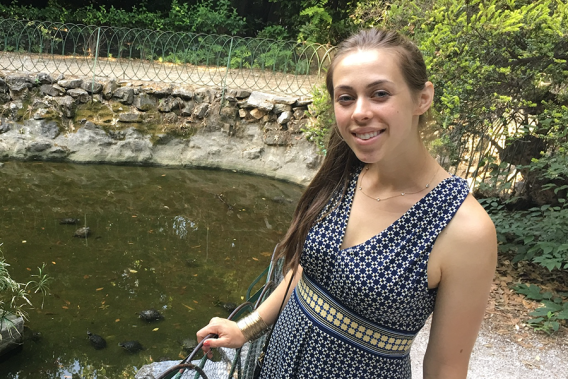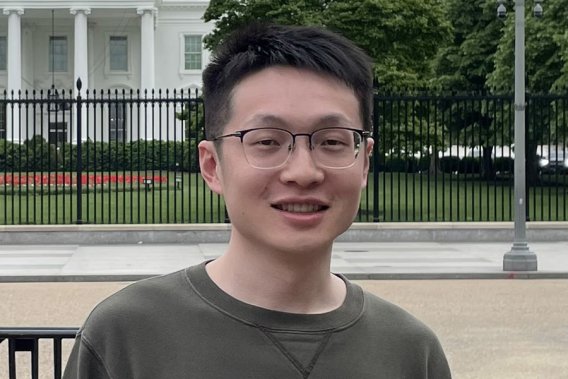CS&E Announces 2024-25 Doctoral Dissertation Fellowship (DDF) Award Winners

Seven Ph.D. students working with CS&E professors have been named Doctoral Dissertation Fellows for the 2024-25 school year. The Doctoral Dissertation Fellowship is a highly competitive fellowship that gives the University’s most accomplished Ph.D. candidates an opportunity to devote full-time effort to an outstanding research project by providing time to finalize and write a dissertation during the fellowship year. The award includes a stipend of $25,000, tuition for up to 14 thesis credits each semester, and subsidized health insurance through the Graduate Assistant Health Plan.
CS&E congratulates the following students on this outstanding accomplishment:
- Athanasios Bacharis (Advisor: Nikolaos Papanikolopoulos)
- Karin de Langis (Advisor: Dongyeop Kang)
- Arshia Zernab Hassan (Advisors: Chad Myers)
- Xinyue Hu (Advisors: Zhi-Li Zhang)
- Lucas Kramer (Advisors: Eric Van Wyk)
- Yijun Lin (Advisors: Yao-Yi Chiang)
- Mingzhou Yang (Advisors: Shashi Shekhar)
Athanasios Bacharis

Bacharis’ work centers around the robot-vision area, focusing on making autonomous robots act on visual information. His research includes active vision approaches, namely, view planning and next-best-view, to tackle the problem of 3D reconstruction via different optimization frameworks. The acquisition of 3D information is crucial for automating tasks, and active vision methods obtain it via optimal inference. Areas of impact include agriculture and healthcare, where 3D models can lead to reduced use of fertilizers via phenotype analysis of crops and effective management of cancer treatments. Bacharis has a strong publication record, with two peer-reviewed conference papers and one journal paper already published. He also has one conference paper under review and two journal papers in the submission process. His publications are featured in prestigious robotic and automation venues, further demonstrating his expertise and the relevance of his research in the field.
Karin de Langis

Karin's thesis works at the intersection of Natural Language Processing (NLP) and cognitive science. Her work uses eye-tracking and other cognitive signals to improve NLP systems in their performance and cognitive interpretability, and to create NLP systems that process language more similarly to humans. Her human-centric approach to NLP is motivated by the possibility of addressing the shortcomings of current statistics-based NLP systems, which often become stuck on explainability and interpretability, resulting in potential biases. This work has most recently been accepted and presented at SIGNLL Conference on Computational Natural Language Learning (CoNLL) conference which has a special focus on theoretically, cognitively and scientifically motivated approaches to computational linguistics.
Arshia Zernab Hassan

Hassan's thesis work delves into developing computational methods for interpreting data from genome wide CRISPR/Cas9 screens. CRISPR/Cas9 is a new approach for genome editing that enables precise, large-scale editing of genomes and construction of mutants in human cells. These are powerful data for inferring functional relationships among genes essential for cancer growth. Moreover, chemical-genetic CRISPR screens, where population of mutant cells are grown in the presence of chemical compounds, help us understand the effect the chemicals have on cancer cells and formulate precise drug solutions. Given the novelty of these experimental technologies, computational methods to process and interpret the resulting data and accurately quantify the various genetic interactions are still quite limited, and this is where Hassan’s dissertation is focused on. Her research extends to developing deep-learning based methods that leverage CRISPR chemical-genetic and other genomic datasets to predict cancer sensitivity to candidate drugs. Her methods on improving information content in CRISPR screens was published in the Molecular Systems Biology journal, a highly visible journal in the computational biology field.
Xinyue Hu

Hu's Ph.D. dissertation is concentrated on how to effectively leverage the power of artificial intelligence and machine learning (AI/ML) – especially deep learning – to tackle challenging and important problems in the design and development of reliable, effective and secure (independent) physical infrastructure networks. More specifically, her research focuses on two critical infrastructures: power grids and communication networks, in particular, emerging 5G networks, both of which not only play a critical role in our daily life but are also vital to the nation’s economic well-being and security. Due to the enormous complexity, diversity, and scale of these two infrastructures, traditional approaches based on (simplified) theoretical models and heuristics-based optimization are no longer sufficient in overcoming many technical challenges in the design and operations of these infrastructures: data-driven machine learning approaches have become increasingly essential. The key question now is: how does one leverage the power of AI/ML without abandoning the rich theory and practical expertise that have accumulated over the years? Hu’s research has pioneered a new paradigm – (domain) knowledge-guided machine learning (KGML) – in tackling challenging and important problems in power grid and communications (e.g., 5G) network infrastructures.
Lucas Kramer

Kramer is now the driving force in designing tools and techniques for building extensible programming languages, with the Minnesota Extensible Language Tools (MELT) group. These are languages that start with a host language such as C or Java, but can then be extended with new syntax (notations) and new semantics (e.g. error-checking analyses or optimizations) over that new syntax and the original host language syntax. One extension that Kramer created was to embed the domain-specific language Halide in MELT's extensible specification of C, called ableC. This extension allows programmers to specify how code working on multi-dimensional matrices is transformed and optimized to make efficient use of hardware. Another embeds the logic-programming language Prolog into ableC; yet another provides a form of nondeterministic parallelism useful in some algorithms that search for a solution in a structured, but very large, search space. The goal of his research is to make building language extensions such as these more practical for non-expert developers. To this end he has made many significant contributions to the MELT group's Silver meta-language, making it easier for extension developers to correctly specify complex language features with minimal boilerplate. Kramer is the lead author of one journal and four conference papers on his work at the University of Minnesota, winning the distinguished paper award for his 2020 paper at the Software Language Engineering conference, "Strategic Tree Rewriting in Attribute Grammars".
Yijun Lin

Lin’s doctoral dissertation focuses on a timely, important topic of spatiotemporal prediction and forecasting using multimodal and multiscale data. Spatiotemporal prediction and forecasting are important scientific problems applicable to diverse phenomena, such as air quality, ambient noise, traffic conditions, and meteorology. Her work also couples the resulting prediction and forecasting with multimodal (e.g., satellite imagery, street-view photos, census records, and human mobility data) and multiscale geographic information (e.g., census records focusing on small tracts vs. neighborhood surveys) to characterize the natural and built environment, facilitating our understanding of the interactions between and within human social systems and the ecosystem. Her work has a wide-reaching impact across multiple domains such as smart cities, urban planning, policymaking, and public health.
Mingzhou Yang

Yang is developing a thesis in the broad area of spatial data mining for problems in transportation. His thesis has both societal and theoretical significance. Societally, climate change is a grand challenge due to the increasing severity and frequency of climate-related disasters such as wildfires, floods, droughts, etc. Thus, many nations are aiming at carbon neutrality (also called net zero) by mid-century to avert the worst impacts of global warming. Improving energy efficiency and reducing toxic emissions in transportation is important because transportation accounts for the vast majority of U.S. petroleum consumption as well as over a third of GHG emissions and over a hundred thousand U.S. deaths annually via air pollution. To accurately quantify the expected environmental cost of vehicles during real-world driving, Yang's thesis explores ways to incorporate physics in the neural network architecture complementing other methods of integration: feature incorporation, and regularization. This approach imposes stringent physical constraints on the neural network model, guaranteeing that its outputs are consistently in accordance with established physical laws for vehicles. Extensive experiments including ablation studies demonstrated the efficacy of incorporating physics into the model.